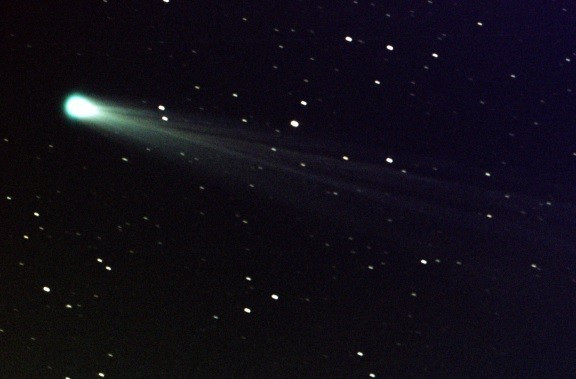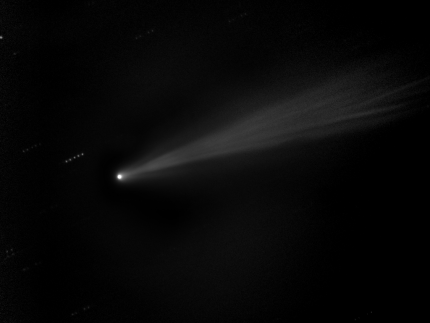Comet Ison Particles to Provide Cosmic Time Capsule as Moment of Truth Approaches

As Comet Ison edges closer to the sun and potential death, IBTimes UK finds out the significance of the "Comet of the Century" and what secrets it will reveal about the solar system.
Ison will reach perihelion - the point where it is closest to the sun - on 28 November. It will either be torn apart or will be catapulted round for its return journey past Earth.
At present, it is travelling at almost 3 million mph and is 10 million miles from the sun. Astronomer Stephen Lowry told IBTimes UK that latest reports appear to show Ison breaking up and that it will not survive its close encounter with the sun.
However, whatever its fate, Ison should provide scientists with details about the solar system and its formation.
Natalie Starkey, postdoctoral research associate in planetary and space sciences at the Open University, will analyse particles of the comet to find out more about its history.
"My research looks at trying to understand the early solar system," Starkey said.
"Comets are the building blocks of the early solar system. They were the very earliest dust and ice from 4.6 billion years ago that was contained out in the outer solar system and formed into these comets.
"Comets are great because they're icy so they've essentially preserved all this very early dust and ice out in the outer solar system away from the sun - it's kind of the deep freeze of the solar system."
Starkey said that we cannot send spacecrafts to the Oort Cloud, where Ison is believed to have come from, because it is too far, so scientists have to wait for one to enter the inner solar system.
"When we get one of these comets in it's exciting because it's like a time travel capsule coming in from the outer solar system and we can sample something that is carrying the oldest material in our solar system."

Sarkey said she will look to analyse the comet's isotopes - the basic forms of the different elements - to understand more about its origins. She said recent research into comets has shown they are more complicated than first believed.
"Some of them contain little pieces of dust that form in the inner solar system which shouldn't be the case on our previous models of how everything formed - so they're telling us a lot more and revealing a lot about how our solar system formed. Comets might have delivered organic material to Earth about three billion years ago. We think they could have brought water, because we don't know where all the water on Earth came from and we don't know where life started."
Speaking about what she hopes to find out from Ison, Starkey said: "We think Ison is entering the solar system for the first time and that is probably the case but if we measure little pieces of it we can build up a better picture of it.
"We can also look at the isotopes of the water... to tell us a lot about where the comet formed. We're building a picture of how everything started and what composition we started with, because we still don't actually know. Ison can give a little snapshot."
The importance of Ison to those analysing its particles is that it will be only the second sample from an identified comet.
"The rest of the time we just have to deal with samples that come raining down," Starkey said, adding that around 40,000 tonnes of dust falls on Earth every year.
Speaking about what she expects from Ison's particles, Starkey said she believes it will have characteristics found in other comets, but that it may throw up a few surprises.
"The chances are it will give us some crazy number that we're not expecting because that is how science works most of the time. And if we find something opposite to what we're expecting, often that is more interesting as there is more to talk about and leads to different models about how everything formed."

If Ison makes it around the Sun and escapes a fiery death, it should produce two meteor showers - one from when it passed Earth on its way to the Sun and another on the way back. "It's unprecedented that we would get two meteor showers at the same time on different sides of the Earth, so that's something to look out for. If Ison doesn't make it, we should still definitely get one."
The particles from the meteor shower or showers will be collected by Nasa using a research version of the U2 spy plane. Starkey revealed that "they've got a research version of the U2 spy plane called the ER2 and this is what Nasa uses. It flies really high in the sky - about 25km - and it has little sticky pads on the bottom of the wings. They open up these little pods with the sticky pads when they're very high up and fly around for hours and wait for the particles to rain down.
"They then fly back down and there's an extremely clean lab over in Huston and they pick the particles off the sticky pads."
Commenting on Ison's fate, she added: "It is very close to the Sun now. At this stage it's got all the Sun's gravity exerting forces on it and it's getting extremely hot. It's quite a small comet, so it has a chance of breaking up. Tomorrow and the next day will be the moment of truth, but I really hope it does survive.
"This is a rare event and so I would urge people - if it survives - to try to have a look for it because it isn't something that happens very often."
Read more:
Comet of the Century: Ison Could Hold Clues to Life on Earth
Death of Ison: Comet of the Century to Fizzle and 'Break Up'
Ison to Become First Comet Visible in Daylight for 330 Years
© Copyright IBTimes 2025. All rights reserved.






















